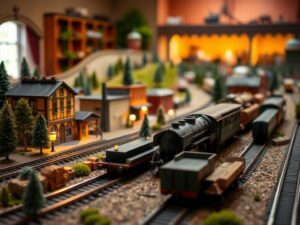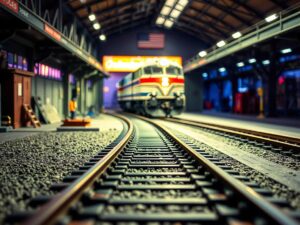Building Elevations and Grades in HO Scale Layouts
Building Elevations and Grades in HO Scale Layouts
Building Elevations and Grades in HO Scale Layouts
Welcome back, railfans! Today we’re diving into the fascinating world of HO scale elevations and grades. These seemingly simple concepts are crucial to creating visually stunning and functionally diverse model railroad layouts.
Whether you’re a budding hobbyist just starting your first layout or a seasoned veteran seeking to elevate (pun intended!) your next project, mastering elevation and grade building is an essential skill.
Understanding Elevation & Grades: More Than Just a Hill!
Think of elevations as the vertical positioning of your track. In model railroading terms, “elevation” simply refers to how high your tracks are above the layout’s baseboard or reference point. Elevations add visual interest and can dramatically impact the flow and realism of your layout.
Grades, on the other hand, describe the slope of your tracks. They are measured as a percentage â essentially, for every 100 feet horizontally, how much vertical rise or fall there is. A common HO scale representation is a “gentle grade” at 1%, which means a rise or fall of 1 inch for every 12 inches of horizontal track length.
Now, you might be thinking: “Does this really matter?” Let me tell you, the answer is a resounding YES! Carefully implemented elevations and grades can achieve some truly remarkable effects in your model railroading:
- Visual Appeal: A simple change in elevation creates depth and perspective, mimicking the natural rolling hills and mountainous terrain you see in real life.
- Realistic Operation: Just like with real trains, grades influence train performance in your model railway.
Grades impact a locomotive’s ability to climb hills efficiently.
Too steep a grade can necessitate stronger locomotives or lead to slow speeds, adding another layer of realism.
- Enhanced Track Layouts: Elevation changes allow you to create curves, bridges, tunnels, and scenic vistas that wouldn’t be possible on flat terrain alone.
Getting Started with HO Scale Elevations & Grades:
Before we delve into construction techniques, let’s break down the essentials:
1. Plan Ahead:
This cannot be stressed enough! Sketch your desired layout with elevation changes clearly marked. Determine where bridges, tunnels, and other features will reside based on your grade plans. Remember to factor in real-world limitations like the size of your space and access points for future maintenance.
2. Material Selection: You’ve got options when it comes to building elevations:
-
Plywood: Sturdy and readily available, plywood forms the backbone of many model railway layouts. Choose 3/8″ or ½” thickness depending on your planned elevation heights.
-
Foam Board: Lightweight and easily shaped, foam board offers excellent flexibility for creating gentle slopes and rolling terrain.
-
Sculpturing Materials: For advanced enthusiasts seeking unparalleled realism, clay, plaster, and other sculpting materials can be used to craft intricate landscapes with realistic contour variations.
3. Tools of the Trade: Assemble a few essential tools:
- Measuring Tape & Ruler: Accuracy is key in model railroading. Use these for precise measurements throughout the building process.
- Utility Knife: For cutting foam board, cork, and other materials to size.
-
Hobby Saw: Helpful for cutting plywood sheets to shape and create support structures.
-
Sandpaper: Smooth rough edges and prepare surfaces for painting or scenic finishing.
4. Tools Specific to Elevations:
- Laser Level: An indispensable tool for achieving accurate horizontal planes when building your track bed.
- Straight Edge & Protractor: Useful for marking precise slopes and ensuring consistent grades across sections of your layout.
Constructing Elevations: Step-by-Step
Let’s illustrate with a common approach to creating a gentle slope on your layout using foam board:
-
Plan Your Slope: Decide on the desired angle of your slope and mark it onto your foam board section using your protractor and straight edge. Remember that 1% grade is fairly standard for smooth, achievable operation in HO scale.
-
Cut Your Foam Board: Carefully cut out the section based on your marked measurements.
-
Position & Secure: Attach the sloped section to your plywood baseboard using construction adhesive or foam board adhesive strips.
- Finishing Touches: Use sand paper to smooth any rough edges and then add layers of scenic material to cover the foam board and create realistic ground forms.
For Plywood Elevations: Follow similar principles, but use your utility knife to score lines along your planned slope contours before carefully cutting them out.
Use a combination of bracing underneath (wooden dowels work well) and support from your track structure itself for added stability.
Building in Realistic Details: Beyond the Basics
- Terrain Variations: Break up your slopes with subtle variations to mimic real landscapes. Combine gentle slopes, curves, dips, and ridges to create visually appealing contours.
- Switchbacks & Hairpins: To conquer steep climbs or create dramatic scenery, consider incorporating switchbacks or hairpins â track configurations that turn back on themselves â to allow for gradual ascent or descent.
Remember: It’s all about experimentation!
- Track Alignment: When laying tracks, always account for the desired grade and elevation. Use a laser level and level building tools to ensure your tracks are laid correctly.
- Grade Consistency: Aim for consistent grades throughout sections of track â this promotes smooth locomotive performance and realistic appearance.
- Don’t Be Afraid to Get Creative!: Elevate (pun intended!) your layout with imaginative solutions â use bridges, tunnels, viaducts, and other structures to highlight changes in elevation and add captivating visual elements.
Essential Insights for Your HO Scale Elevations & Grades:
- Start Simple: Don’t feel pressured to create complex elevations right away. Practice with small slopes and gentle grades on your first projects before tackling larger or more challenging builds.
-
Observe Nature: Spend time observing hills, valleys, and mountain ranges in your own surroundings â youâll gather inspiration for realistic shapes and textures for your model railroad.
-
Resources Galore!
The model railroading community is brimming with helpful resources! Books, magazines, websites, and online forums offer valuable tips, project ideas, and inspiration. Join a local club or connect with other enthusiasts online to share experiences and learn from each other’s projects.
So there you have it, fellow railfans â the fundamental knowledge to conquer HO scale elevations and grades. Remember, itâs about taking those first steps, experimenting, and above all, enjoying the process! Happy building!




